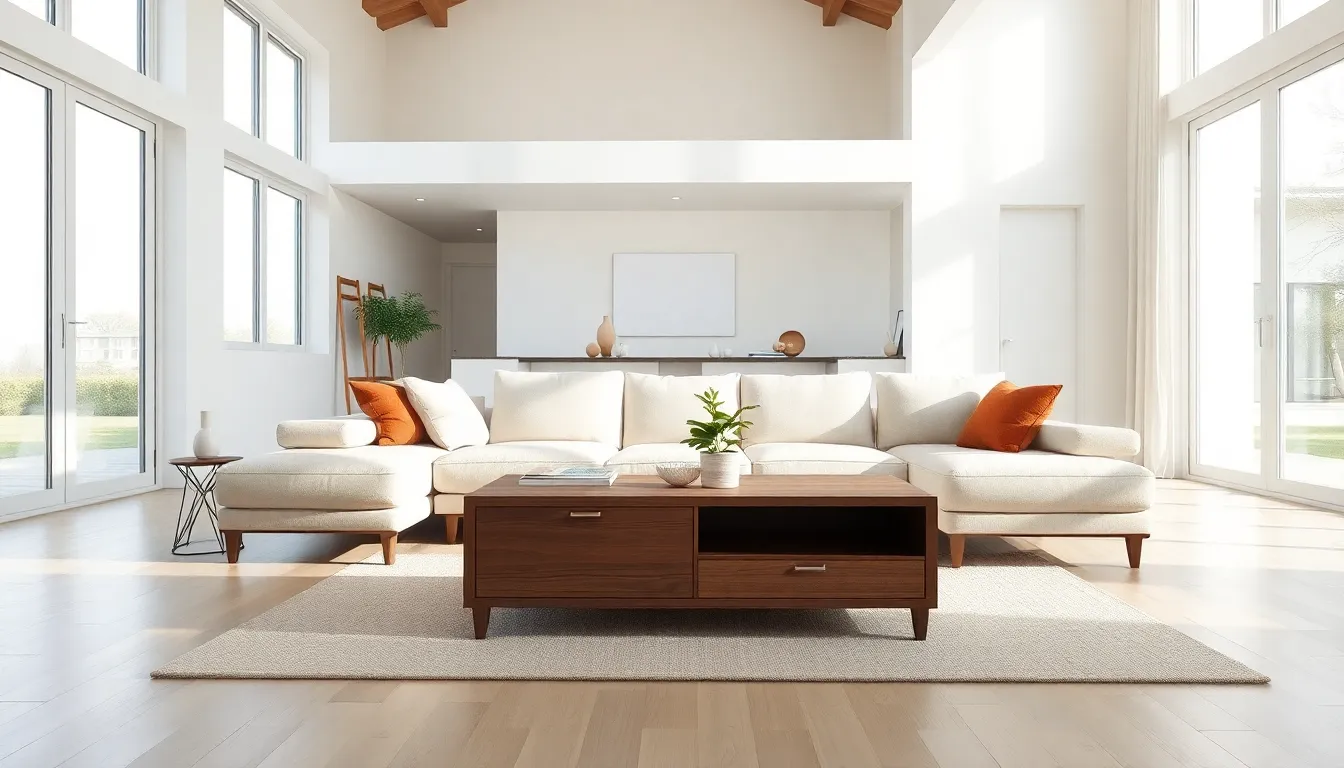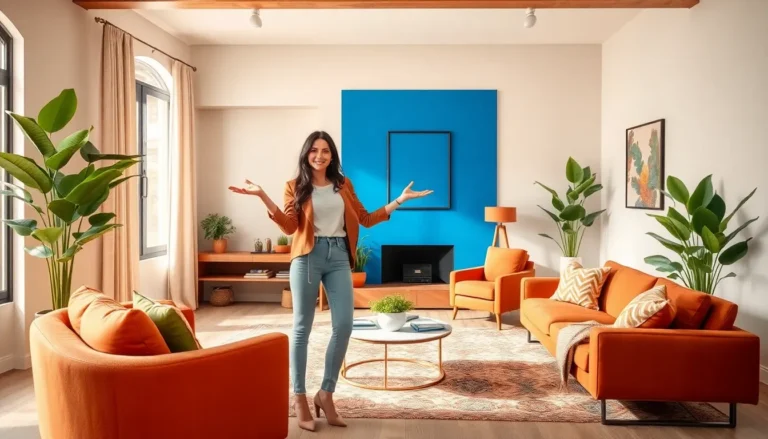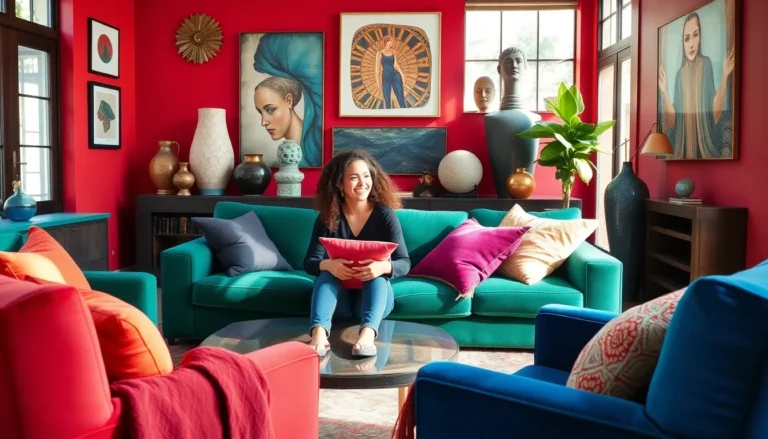Table of Contents
ToggleIn a world overflowing with clutter, minimalist interior trends are like a breath of fresh air—think of it as decluttering your mind while your living space gets a chic makeover. This design philosophy isn’t just about having fewer things; it’s about creating a serene environment where every piece serves a purpose, and every corner sparks joy. Who knew that less could actually mean more?
Imagine walking into a room that feels like a calm oasis rather than a chaotic storage unit. Minimalism invites tranquility and elegance, allowing personality to shine through without the distraction of unnecessary knick-knacks. So, if you’re ready to transform your space from “what on earth is that?” to “wow, how serene!” dive into the world of minimalist interior trends. It’s time to embrace simplicity and find joy in the art of less.
Overview of Minimalist Interior Trends
Minimalist interior trends focus on simplicity, functionality, and clean lines. These designs showcase open spaces that prioritize the essentials. Soft color palettes often dominate, using whites, beiges, and pastels to create a soothing atmosphere. Natural light plays a significant role, allowing rooms to feel more expansive and inviting.
Furniture selection emphasizes quality over quantity. Pieces feature streamlined designs, often in natural materials like wood and metal. Multi-functional furniture is also popular, satisfying both aesthetic and practical needs. Thoughtful placement enhances flow and promotes a sense of calm.
Accessories maintain a delicate balance, with fewer items designed to serve a purpose. Artworks are chosen carefully, making impactful statements without overwhelming the space. Plants provide warmth and life, contributing an organic touch without detracting from simplicity.
Tech integration represents another facet of modern minimalism, focusing on smart appliances that blend seamlessly into the background. This approach reduces visual noise while maximizing comfort and convenience. Outdoor areas mirror these principles, incorporating minimalist landscaping features that promote relaxation.
Trends such as sustainable materials and eco-friendly practices resonate with minimalist design, aligning with the philosophy of thoughtful consumption. Emphasizing quality craftsmanship supports both durability and aesthetic appeal, reinforcing the core value of minimalism: less is more.
Key Characteristics of Minimalist Design
Minimalist design centers on core elements that emphasize clarity and simplicity. It promotes a serene environment that enhances well-being through intentional choices.
Simplicity and Functionality
Simplicity remains pivotal in minimalist interiors. Each item serves a distinct purpose, reducing unnecessary distractions. Functionality comes first, as spaces incorporate furniture that adapts to multiple uses. For instance, a coffee table might double as storage. Designers eliminate clutter by selecting few, but meaningful, pieces that elevate the overall aesthetic. Open floor plans enhance this trend, allowing for fluid movement while maximizing space utilization. Achieving a calm vibe becomes effortless when everything has a place without sacrificing practicality.
Neutral Color Palettes
Neutral color palettes play a vital role in minimalist design. Shades like soft whites, gentle beiges, and light pastels dominate these spaces. Such hues create an inviting atmosphere that feels expansive and airy. Variations in texture and subtle contrasts in these colors add depth while maintaining a clean visual. Accents can emerge from carefully chosen materials, enhancing warmth without detracting from simplicity. Natural light complements these palettes, further enhancing the tranquil space. This strategic use of color amplifies the minimalist approach by focusing on peace and serenity in each room.
Popular Minimalist Interior Trends
Minimalist interior design trends captivate with their simplicity and intentionality. These styles prioritize clean lines and functional spaces, enhancing serene living environments.
Open Spaces and Layouts
Open spaces embrace fluidity, allowing effortless movement throughout a home. Layouts favor a lack of barriers, fostering connectivity between rooms. An unobstructed arrangement cultivates a sense of airiness, making smaller areas feel more expansive. Purposeful furniture placement creates zones without visual clutter. Integrating large windows enhances natural light, while unobtrusive décor accentuates the spaciousness. Effective use of negative space contributes to visual calm, ensuring each design element serves a specific role.
Natural Materials and Textures
Natural materials create warmth and add depth to minimalist interiors. Designers often choose wood, stone, and linen for their organic appeal. These textures invite connection to nature, promoting a tranquil atmosphere in each room. Subtle variations in materials contribute richness without overwhelming simplicity. High-quality finishes and craftsmanship elevate everyday items, encouraging appreciation for durability and beauty. Incorporating indoor plants aligns with environmental sustainability while enhancing aesthetics. Minimalist designs focus on harmonizing these elements, achieving a cohesive look that highlights both function and style.
Incorporating Minimalism into Your Home
Minimalism invites a thoughtful approach to home design. Integrating essential elements enhances both comfort and functionality.
Selecting Essential Furniture
Choosing essential furniture shapes the minimalist environment. Each piece must prioritize functionality, ensuring that every item serves a purpose. Consider multi-functional furniture like a coffee table that doubles as storage. Streamlined designs provide elegance while avoiding clutter. Natural materials, such as wood and metal, foster warmth and durability. Limit the number of items, opting for quality over quantity. This focus creates tranquility throughout the space. Prioritize pieces that resonate with your lifestyle, combining both aesthetic appeal and practicality. Connection to the space is essential; therefore, each selection should reflect intentional choices.
Using Lighting to Enhance Space
Maximizing natural light elevates the minimalist aesthetic. Incorporate large windows to invite sunlight, creating an open and airy atmosphere. Consider soft, diffused lighting options for a calming effect during the evening. Layering light through different sources adds depth to the environment while maintaining simplicity. Statement fixtures can serve as focal points, drawing attention without overwhelming the design. Use dimmable lights to adjust ambiance according to need. Consistency in lighting styles underlines the minimalist theme, promoting a cohesive look. Pay attention to how light interacts with colors and textures, enhancing the overall serenity of the space.
Conclusion
Embracing minimalist interior trends can transform any living space into a serene retreat. By prioritizing simplicity and functionality individuals can cultivate an environment that promotes peace and well-being. The focus on quality over quantity ensures that every piece serves a purpose while enhancing the overall aesthetic.
Natural materials and soft color palettes contribute to a calming atmosphere that invites relaxation. With thoughtful design choices and an emphasis on intentional living minimalism offers a pathway to a more joyful and tranquil home. Adopting these principles not only elevates the visual appeal but also supports a sustainable lifestyle, making minimalism a timeless choice for modern interiors.








